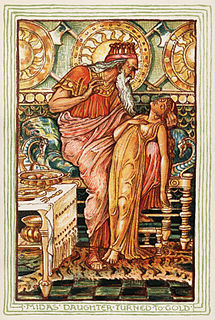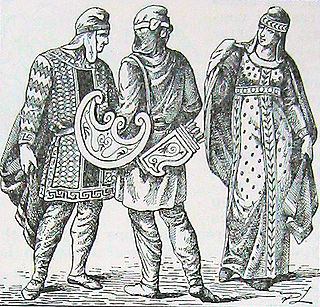
Alyattes, sometimes described as Alyattes I, was the fourth king of the Mermnad dynasty in Lydia, the son of Sadyattes, grandson of Ardys, and great-grandson of Gyges. He died after a reign of 57 years and was succeeded by his son Croesus.

A coin is a small, flat, round piece of metal or plastic used primarily as a medium of exchange or legal tender. They are standardized in weight, and produced in large quantities at a mint in order to facilitate trade. They are most often issued by a government. Coins often have images, numerals, or text on them. Obverse and its opposite, reverse, refer to the two flat faces of coins and medals. In this usage, obverse means the front face of the object and reverse means the back face. The obverse of a coin is commonly called heads, because it often depicts the head of a prominent person, and the reverse tails.

Lydia was an Iron Age kingdom of western Asia Minor located generally east of ancient Ionia in the modern western Turkish provinces of Uşak, Manisa and inland Izmir. The ethnic group inhabiting this kingdom are known as the Lydians, and their language, known as Lydian, was a member of the Anatolian branch of the Indo-European language family. The capital of Lydia was Sardis.

Midas is the name of one of at least three members of the royal house of Phrygia.

Electrum is a naturally occurring alloy of gold and silver, with trace amounts of copper and other metals. Its color ranges from pale to bright yellow, depending on the proportions of gold and silver. It has been produced artificially, and is also known as "green gold".

Croesus was the king of Lydia, who reigned from 585 BC until his defeat by the Persian king Cyrus the Great in 547 or 546 BC.

Gyges was the founder of the Mermnad dynasty of Lydian kings and the first known king of the Lydian kingdom to have attempted to transform it into a powerful empire.
Gordias was the name of at least two members of the royal house of Phrygia.
Sadyattes was the third king of the Mermnad dynasty in Lydia, the son of Ardys and the grandson of Gyges of Lydia.

The history of coins stretches back to the first millennium BC/BCE. Notable examples of coins include the Lydian Lion coins, Persian daric and siglos, Tong Bei, the dirham and gold dinar.

The Phrygians were an ancient Indo-European speaking people, who inhabited central-western Anatolia in antiquity. They were related to the Greeks.

The stater was an ancient coin used in various regions of Greece. The term is also used for similar coins, imitating Greek staters, minted elsewhere in ancient Europe.

Tripolis on the Meander – also Neapolis, Apollonia, and Antoniopolis – was an ancient city on the borders of Phrygia, Caria and Lydia, on the northern bank of the upper course of the Maeander, and on the road leading from Sardes by Philadelphia to Laodicea ad Lycum. It was situated 20 km to the northwest of Hierapolis.

Cyme or Cumae was an Aeolian city in Aeolis close to the kingdom of Lydia.

In classical antiquity, Phrygia was a kingdom in the west central part of Anatolia, in what is now Asian Turkey, centered on the Sangarios River. After its conquest, it became a region of the great empires of the time.

Gordion was the capital city of ancient Phrygia. It was located at the site of modern Yassıhüyük, about 70–80 km (43–50 mi) southwest of Ankara, in the immediate vicinity of Polatlı district. Gordion's location at the confluence of the Sakarya and Porsuk rivers gave it a strategic location with control over fertile land. Gordion lies where the ancient road between Lydia and Assyria/Babylonia crossed the Sangarius river. Occupation at the site is attested from the Early Bronze Age continuously until the 4th century CE and again in the 13th and 14th centuries CE. The Citadel Mound at Gordion is approximately 13.5 hectares in size, and at its height habitation extended beyond this in an area approximately 100 hectares in size. Gordion is the type site of Phrygian civilization, and its well-preserved destruction level of c. 800 BCE is a chronological linchpin in the region. The long tradition of tumuli at the site is an important record of elite monumentality and burial practice during the Iron Age.

The prehistory of Anatolia stretches from the Paleolithic era through to the appearance of classical civilisation in the middle of the 1st millennium BC. It is generally regarded as being divided into three ages reflecting the dominant materials used for the making of domestic implements and weapons: Stone Age, Bronze Age and Iron Age. The term Copper Age (Chalcolithic) is used to denote the period straddling the stone and Bronze Ages.
Hermodike I has been attributed with inventing the Greek written script, i.e. the transfer of earlier technical knowledge from Phrygia into ancient Greek society through Aeolis. She is referred to by Aristotle. The same name was given as Demodike by Pollux. Academics state that Aristotle and Pollux, though ancient commentators, were not historians and so their unsubstantiated opinions may be misleading. Other historians have given the name as Hermodice or Damodice.

The Croeseid, anciently Kroiseioi stateres, was a type of coin, either in gold or silver, which was minted in Sardis by the king of Lydia Croesus from around 550 BC. Croesus is credited with issuing the first true gold coins with a standardised purity for general circulation, and the world's first bimetallic monetary system.

















